by Laura Phelan, Managing Director cut-e Ireland, an Aon company
In the increasingly changeable world of expanding digitisation and big data, and with new HR technologies constantly appearing, companies run the risk of inadvertently treating their people as objects; nothing more than ID numbers and data points. Applying a generic approach to a group of individuals, joined together under the umbrella of the company, will see the organisation lose the ongoing battle for retention of top talent.
Companies need to focus on the human side of their workforce to stay ahead.
By truly understanding their employees and their changing needs and aspirations, they can create agile workplaces and teams, build more moments of interaction, inspire people and evolve the employee experience through continuous dialogue. By establishing this environment of engagement, the peak performance of the individuals will be unlocked, and this will in turn feed into the sustainability of the organisation.
Organisations that are struggling to put their people’s needs to the forefront of the companies’ evolution need to change. Aon believes that the individual employee’s success and the success of the organisation are the same thing. However, the reality might look quite different.
The 2018 Aon Global Employee Experience Research revealed that desire for a continuous dialogue between organisations and its employees is strong, but organisations’ readiness is low. In a study of 1,500 HR professionals across 46 countries, employing in excess of 22 million employees, 75 per cent of companies reported that they want to measure almost all lifecycle stages by 2020. However, only 36 per cent of organisations are ready for this change.
The use of insightful data and perceptive analysis can identify the best methods of improvement; for example, what behaviours correlate best with engaged employees of the organisation. Effective use of data can then be used to develop unengaged employees to become better, by addressing their needs and concerns. Data can support employees with manager capability and integrate the collected information into a full lifecycle story. These robust, comprehensive diagnoses will clearly identify the barriers to success of individuals in the organisation and show the biggest opportunities for positive change; such as the evolution of leadership, how effectively managers work, and how successfully colleagues collaborate.
The result? Change that lasts: people who feel heard, connected and empowered to perform at their best; a cycle of insight, interaction and inspiration that drives ongoing improvement; and a maintained positive momentum for change in an evolving world.











































